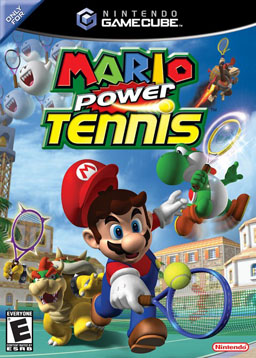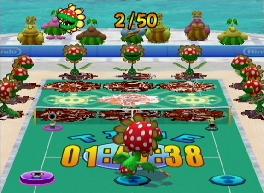Mario Power Tennis facts for kids
Quick facts for kids Mario Power Tennis |
|
|---|---|

North American GameCube box art
|
|
| Developer(s) | Camelot Software Planning |
| Publisher(s) | Nintendo |
| Director(s) | Haruki Kodera |
| Producer(s) | Shinji Hatano Hiroyuki Takahashi Shugo Takahashi |
| Designer(s) | Hiroyuki Takahashi Shugo Takahashi |
| Composer(s) | Motoi Sakuraba |
| Series | Mario Tennis |
| Platform(s) | GameCube, Wii |
| Release date(s) | GameCube
|
| Genre(s) | Sports (Tennis) |
| Mode(s) | Single-player, multiplayer |
Mario Power Tennis is a fun sports game where popular Mario characters play tennis! It was made by Camelot Software Planning and released by Nintendo for the GameCube in 2004. This game is the fourth one in the Mario Tennis series. It's like a follow-up to the Mario Tennis game on the Nintendo 64.
Later, in 2009, Mario Power Tennis was also released for the Wii console. This version was part of the New Play Control! series. In 2012, it was re-released again as a Nintendo Selects title. There was also a similar handheld game, Mario Tennis: Power Tour, released for the Game Boy Advance.
Mario Power Tennis brings together many characters, themes, and places from the Mario world. You can play regular tennis matches. But there are also special game types with different rules and goals. Some courts are "Gimmick" courts. These courts have unique features that change how you play. The game has 18 characters you can play as. Each character has a special playing style and two unique "Power Shots."
The GameCube version of the game was generally well-liked. People praised how much there was to do and how varied the game was. However, some thought the Power Shot animations took too long. The Wii version got mixed reviews. Its graphics and multiplayer modes were liked, but the motion controls received some criticism.
Contents
How to Play Mario Power Tennis
Mario Power Tennis offers many ways to play tennis. You can choose from different characters, courts, and game types. All of these are based on the Mario universe.
Tennis Courts and Special Rules
The game has standard tennis courts. But it mostly features "Gimmick" courts. These courts are designed like places from Mario games. For example, the Luigi's Mansion court has ghosts that can slow you down. These special courts add fun challenges to your matches.
Besides regular tennis, you can play with different rules.
- Ring Shot: In this mode, you score points by hitting the ball through rings. The bigger the ring, the more points you get. You win when you reach a certain number of points.
- Item Battle: Here, characters use items from the Mario games. These items can help you or mess with your opponent's game.
Game Modes and Challenges
The main part of the game is "Tournament Mode." You play through a series of events that get harder as you go. Winning these tournaments helps you unlock new characters. You can play tournaments as "doubles" (two players per side) or "singles" (one player per side). Tournaments are available on both Gimmick courts and standard courts.
"Special Games" are another fun option. In these games, you try to complete specific tennis challenges on Gimmick courts. For example, "Tic-Tac-Glow" asks you to hit water balls to free Shine Sprites. This is a nod to the game Super Mario Sunshine.
Mario Power Tennis also supports up to four players. You can play with friends in "Exhibition Mode." This is where you can choose your opponents and set up the match rules. You can pick the difficulty, the court, and how many games or sets you need to win.
Characters and Power Shots
The game has 18 characters from the Mario series. Many characters, like Wario, were in previous Mario games. But for some, like Wiggler, this was their first time as a playable character.
All characters fit into one of six playing styles:
- All-around
- Technical
- Power
- Speed
- Defensive
- Tricky
Each character has two special moves called "Power Shots." These are very strong moves that come with cool animations. You can only use them a few times in a match. They usually help you defend a point or score one. You can also use regular tennis moves like slices, dropshots, and lobs anytime.
How Mario Power Tennis Was Made
Mario Power Tennis was created by Camelot Software Planning. A team of about 30 people worked on the game. The main people in charge were brothers Hiroyuki and Shugo Takahashi.
The game was first shown in a Japanese magazine called Famitsu in 2002. Later, it was presented at the E3 conference in 2004. The developers wanted to make sure the game was new and exciting. They used ideas and technology from Mario Golf: Toadstool Tour, which was being made at the same time.
After the game was released, Hiroyuki Takahashi shared more about its creation. He said that Nintendo helped a lot with the voice acting and animations. This made the game's graphics look much better. Takahashi also explained why they didn't include role-playing game elements. He felt those were better suited for handheld games.
The ideas for the themed courts came from many brainstorming sessions. They chose courts that would remind players of older Mario games. They also wanted to introduce new players to games they might not have played before. Making the opening videos and special games was a big challenge for the team.
Nintendo worked with the Lawn Tennis Association in the UK in 2005. They promoted Power Tennis at tennis events like Wimbledon. The game was also offered as a prize in a magazine.
In 2008, Nintendo announced they would re-release the game for the Wii. This new version, part of the New Play Control! series, let players use the Wii Remote. You could swing the Remote like a tennis racket to hit forehands and backhands. The Wii version came out in Japan in January 2009. It was released in other countries in March 2009.
See also
 In Spanish: Mario Power Tennis para niños
In Spanish: Mario Power Tennis para niños


